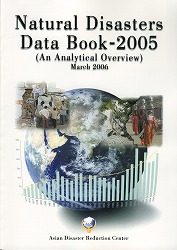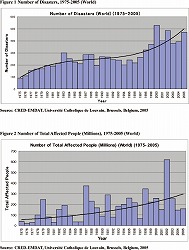Natural Disasters Data Book 2005

(An Analytical Overview) March 2006
foreword
 The year 2005 witnessed several severe natural disasters around the world. The South Asian Earthquake that struck India and Pakistan yielded the highest death toll, the floods in India and China affected the greatest number of people, and Hurricanes Katrina and Wilma in the US produced the most extensive economic damage. The South Asian Earthquake severely impacted the development and economic advancement of Pakistan and India, and floods and torrential rains in India and China caused serious damages in those countries. Consequently, these disasters affected the entire Asian region and posed severe setbacks to economic development. Droughts were also experienced in many African countries in 2005, resulting in extensive human sufferings and economic damage. Even more unexpectedly, Europe experienced floods and extreme temperatures, as it had in 2004, which claimed a considerable number of human lives and caused extensive suffering in the region. Oceania also experienced severe storms and volcanic activities that affected many people and caused significant economic damage.
The year 2005 witnessed several severe natural disasters around the world. The South Asian Earthquake that struck India and Pakistan yielded the highest death toll, the floods in India and China affected the greatest number of people, and Hurricanes Katrina and Wilma in the US produced the most extensive economic damage. The South Asian Earthquake severely impacted the development and economic advancement of Pakistan and India, and floods and torrential rains in India and China caused serious damages in those countries. Consequently, these disasters affected the entire Asian region and posed severe setbacks to economic development. Droughts were also experienced in many African countries in 2005, resulting in extensive human sufferings and economic damage. Even more unexpectedly, Europe experienced floods and extreme temperatures, as it had in 2004, which claimed a considerable number of human lives and caused extensive suffering in the region. Oceania also experienced severe storms and volcanic activities that affected many people and caused significant economic damage.
These natural disasters have clearly had serious consequences for human society, national economies, and the global environment. The exponential increase in economic losses associated with natural hazards in the developing countries has posed a considerable obstacle to development. Thus, the devastation caused by natural disasters and the economic uncertainties they create have had an adverse effect on the ability of developing countries to compete in the global economy. The statistics for the last 30 years clearly show that Asia is the most disaster-afflicted region in the world, accounting for about 90% of all those affected by disasters, and more than 50% of the total deaths and economic losses. It is therefore imperative that we analyze past disasters and look at annual trends from the perspective of development mechanisms.
We have compiled this publication to analyze the natural disaster trends in the year 2005 for the purpose of accelerating and strengthening global and regional socio-economic frameworks for addressing the consequences of natural disasters and designing effective disaster reduction mechanisms. We hope this publication will be of use not only to policy planners, researchers, and scholars, but also to grass-roots level promoters of development initiatives. We sincerely hope that this data book will further our efforts to transform the total disaster risk management approach into an instrument for global sustainable development.
March 2006
Contents
Chapter 1
1-1 Trends in Natural Disaster Damage and Characteristics
1-2 Regional Vulnerability: Disaster-Prone Asia
1-3 Vulnerabilities of Countries with Small Economies and Populations
Chapter 2
Natural Disasters and Sustainable Development
2-1 Human Development and Natural Disasters
2-2 Gender Issues and Natural Disaster Impacts
2-3 The Economics and Natural Disasters
2-4 Disaster Classification and the Impact of Development Characteristics
Chapter 3
Regional Characteristics of Natural Disasters
3-1 Proportion of Natural Disasters by Region
3-2 Natural Disasters Around the World
3-2-1 Characteristics of Disasters in Africa
3-2-2 Characteristics of Disasters in the Americas
3-2-3 Characteristics of Disasters in Asia
3-2-4 Characteristics of Disasters in Europe
3-2-5 Characteristics of Disasters in Oceania
Chapter 4
Overview of Natural Disasters in Asian and ADRC Member Countries
4-1 Types of Disasters and Their Effects on Asian and ADRC Member Countries
4-2 Disaster Profiles of the Asian and ADRC Member Countries
4-3 Conclusions

